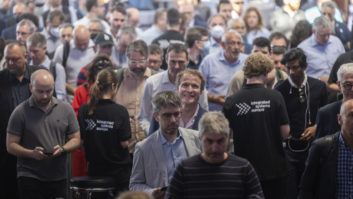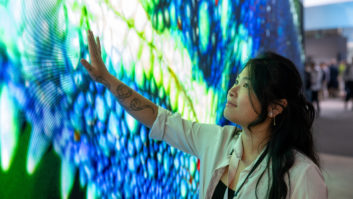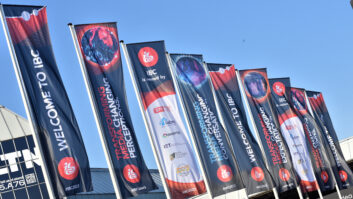
Following the release of AVIXA’s Industry Outlook and Trends Analysis (IOTA) Duncan Proctor talks to Sean Wargo, the association’s senior director of market intelligence, about the key points from the research.
Firstly, can you outline how the report was put together?
This is our second year with this methodology. We went through a major revision last year and now are refining that as we go forward.
I would say overall we kept pretty consistent with some of the findings in terms of per cent growth. We’re tending to look a lot like GDP that’s one of the key indicators for this market as you would expect since pro AV is implemented in pretty much every different vertical. So the industry tends to look like the world economies in total.
We also keep an eye on things like construction, corporate profits, etc. as leading indicators for what we might see in our market. But overall pretty consistent with GDP globally around four to five per cent compound annual growth now until 2023. That leads us to almost a $230 billion dollar industry as we go out to 2023, from more than $180 billion in 2018.
One of the big categories that everybody focuses on is corporate in this space – outfitting corporate headquarters with collaboration technologies, digital signage that’s still a big chunk of this market, but where we’re seeing more of the growth is in some newer or less traditional markets. A good example of that would be healthcare, which has really come up as a big growth area for integrators and end users. Thanks as we all know to ageing populations and we all continue to get sick and that keeps that market fairly vibrant. And so I think what you’re finally seeing is some investments in technologies to support, enable, and facilitate better care. Whether it’s waiting rooms all the way into patient care, surgery, operation, operating facilities, lots of AV technologies kind of percolating that market so that’s a big growth area – double what the total market is growing at.
Another big one that’s somewhat surprising to me is Direct View LED, which is a technology a lot of people have been watching. We have seen it in stadiums where there is the appetite and the ability to invest significantly in those screens, but as those costs have come down and the supply chain has improved, it is starting to become more viable, whether for digital signage installation or in cinema as a potential upgrade for primary displays. Cinema itself is now one of our expected fastest growing markets as we go out to the outer ranges, both because of Direct View being a potential upgrade path for theatres as well as digital signage facilitating investment in the lobby areas and the food and beverage areas of cinemas. Those combined things are pushing cinema into a top growing vertical market with 8.6% CAGR from 2018 to 2023.
Those sectors have surprised you or the rate of growth has?
Yes I think because the industry tends to be very, very focused on the traditional categories – higher ed and corporate. I would say highlighting something like healthcare is surprising to parts of the market – those that are not yet capitalising on those opportunities because it is a challenge to get into something like healthcare. There are specific requirements, specific technologies – in the United States we have HIPAA regulations that protect patient information. Data security has to be a big piece of what you’re providing. That is a surprise to the market, though, you talk to some and they’re like “oh yeah of course we’ve been seeing this for awhile.”
Cinema because it is a smaller sector and had already gone through an upgrade path within the last three, four, five years as we went to digital cinema, that’s more of a surprise I think to people. That is good news for some of the sectors and for integrator-installers who were involved in that space too. Surprises – I frame that in terms of information that’s new and different and unexpected to the market as a whole.
Moving onto IP-based distribution, as that’s mentioned as a disruptive technology, what ways do you see it being disruptive and in what sectors?
It is a new requirement, and this is where AV and IT collide. The networking infrastructure has been built out, has matured and AV is viewed as potentially another node on that. As an AV integrator, you now have to consider how to utilise that back-end structure, whether it’s optimised for your needs as an AV integrator/installer.
Knowing that doing things like distributing video content to those hungry digital signs, that we are now installing everywhere, requires a significant amount of bandwidth. Integrators across many installation areas are having to build out that capability, hire new staff or train existing staff how to work with IP-based distribution over a network. That was a big theme at InfoComm. If you talk to people that were at the show, a lot of them were saying “yeah I’m here to get basic training in IP-based distribution. I need to know how to do that in order to better serve my clients and handle requirements.” That was a big theme that we’re seeing, pretty much across the board.
It has historically been the case in unified communications. That was already how calls were being made on the back of voice-over-IP-based products, so it was a little more mature there, but it is now cutting into more traditional AV areas like audio and video distribution. It is quickly becoming an across the board phenomenon and you have to be working within that infrastructure, those requirements to be able to serve the client better.
And in terms the relationship between the IT department and the integrator, is that becoming one of increased co-operation or is it more competitive?
I think it has almost had to become more collaborative. In some cases it can feel a little bit competitive because the IT department in many cases is involved in scoping, sourcing the solution and that can feel like it’s very focused on costs. Cost of hardware, cost of software so that it gets very nuts and bolts. Whereas the AV integrator is thinking about the solution that they’re trying to provide and making sure it’s a quality experience. But the reality is they’ve had to collaborate in order to ensure exceptional experience across all these different application areas, whether it is the digital sign or a conference and collaboration solution. They’re having to work together. In some cases, you look at an industry like retail or even sports venues – who the integrator is dealing with can be a little bit different and there is perhaps some desire to move upmarket to a bigger decision-maker, but the reality is in a lot of cases you’re back to the IT department to try to work together on the end solution that’s being provided. Collaboration I would view as the current way of describing that [relationship].
“It can feel a little bit competitive because the IT department in many cases is involved in scoping, sourcing the solution and that can feel like it is very focused on costs”
Around collaboration technology, the industry has been shifting from hardware to software and cloud-based solutions over the last few years.
It has certainly been a disruption, particularly for a hardware-based industry used to selling boxes, products, hardware components. With software services and cloud services coming in, it leaves integrators wondering ‘how do I get a piece of that pie?’, especially if somebody is using let’s say a Skype service for their collaboration, how does an integrator come into the mix?
The space itself often has to be optimised – it is not as simple as buy and install and you are done. I think the quality of that experience is pushing some people to look bigger picture: ‘well is my room set up so that noise is not an issue? What about the mic placement, the screen placement, the speaker placement – is that all optimised to ensure that everybody has a good experience when they’re in that space?’ Leaving aside the individual offices for a moment, just the number of huddle spaces and larger conference rooms that are still out there, that’s where the integrator’s strength lies in. Taking that experience beyond just a simple cloud-based or simple bundled hardware package to something higher quality – that opportunity still exists.
The cloud-based services are coming out with these packaged bundles, which I think serves some of the market, but there’s still this opportunity out there for integrators to take it to another level. That’s what you’re hearing, how they can fully integrate to make that a bit better experience for the user. That is definitely a part of the challenge these days – how to work with a cloud service as an integrator.
Where are we with LED and LCD display technologies? Is LED at a point where it can compete on a like-for-like basis yet or is it still based on application?
I think we are still in that market of application and it bifurcates a little bit, and actually the third technology you could add into that discussion is projection since there’s a scale of different opportunities that exist.
You’ve got smaller conference rooms or even food and beverage areas where a less than 50 or 60in display is okay. And clearly the price point for LCD on that is most conducive to those applications. Wherever you need display proliferation for lots of different purposes, in some cases even videowalls, where you’re showing lots of different information, an LCD type of technology is going to be the most cost effective. However, you get up to a certain size, most say it is above 100in, and that’s where LED can shine or projection becomes the more cost effective. It is still the case in most instances – a projector with a screen is going to be cheaper and easier to install than LED.
It is getting better, and I think you get up to really big displays, especially in situations where light is harder to control like a stadium then that is where LED has really shined against projector technology. But that is a debate that is still happens like in cinema – do we go to LED technology, which offers a really nice resolution now since pixel pitch has become so small? As costs come down, that becomes a viable alternative to projection technology. Where we’re seeing more of the interplay and competition is between LED and projection, since LCD really is a smaller format – it does really well at that less than 100in types of installation and is still very cost effective there.
As for more specialised media players, are you predicting that they will be phased out and generic IT servers will replace that technology?
It has become a big question. It has also become a question of the more that it goes to generic white box sorts of server technologies – does it make it harder for the AV integrator to stay in that space? So far what we’ve seen is there is still specific need for those media servers if there is a heavy task, lots of distribution, a focus on a set of displays or certain requirements. Crestron, AMX, all the others − they are still very active. They have got products that all work seamlessly together. They handle those tasks really well. That is staying a part of the market even as the generic boxes come in.
I think if anything what is happened so far is while specialised media players may have given up some ground, I think the net has actually been an increased market size so that there’s areas where the white label, the generic servers can play and expand out opportunities for an integrator/installer in the market. So it has not fully replaced, nor do we expect that it will; there is a chunk of this market, even if it is say 30 to 40 per cent that specific media players maintain as this market grows. Servers are becoming more and more required to handle all the various tasks from control of lighting, distribution, content and interactivity at the point of the display. There are a lot of purposes there that have to be served by these products, so it keeps an opportunity going for both as we go forward.
“That is definitely a part of the challenge these days – how to work with a cloud service as an integrator”
Another area highlighted in the report is voice control. By 2023 do you think voice control will have made serious inroads into a number of technology areas?
Where we are expecting the most is hospitality and in-room experience. That is where voice is making its first foray in a big way. You’re seeing some hotels experimenting with that. It is starting to happen a little bit in conference rooms, but as we look at the forecast range out to 2023, I would expect this story to have evolved. But I think, given the user complexities of the conference room and data security privacy etc., I do not expect it to become the lion’s share of control systems within conference rooms during that timeframe. I think it is going to be more of a niche percentage – around 9/10 per cent as we go to 2023.
You also predict that Asia will overtake North America as the largest pro AV market.
I would return to where we started with GDP. Looking at straight GDP and the growth that is happening in Asia, albeit slowing somewhat of late. Everybody seems to be very concerned about the 2021 timeframe as far as a slowdown globally for macroeconomics and that may force us to revise a bit. I don’t know that that would change Asia’s story or China’s story, I think as we go out, that compound annual growth rate really starts to have its effect. North America is chugging along at two to four per cent depending on the forecasts and models. China is double that and at a certain point that economy starts to exceed the US and North America. That is really what it’s about − the maturing of their economy, the sectors building out. All that presents great opportunity for pro AV.
Do you have any predictions regarding the fallout from Brexit?
It’s one of those things like the stock market they often talked about things being baked in to the expectation. That [Brexit] has been largely accounted for in the forecasts and is why Europe’s forecast for growth is more muted. I think forecasters have expected that that was a headwind and at a certain point, that perhaps relaxes as deals are struck and we’re already starting to see that happen.
I would not expect it to be any worse than what is already forecast. If anything, what we should start seeing is some upside as things start coming together – that it becomes a more known commodity. How is the removal going to work? From a practical and logistics standpoint. How do countries and economies account for that? Versus assumptions and guesswork, which it has largely been. Typically what happens in these forecasting cycles is people skew more conservative and pessimistic and then the reality starts to set in. Sometimes it can be worse than expected but more often you start to see a return to a bit more positivity, more specific estimates so that the problems, the negative forecast becomes isolated to specific areas. In short, I think that has already been baked into that EMEA and Europe story by and large.







